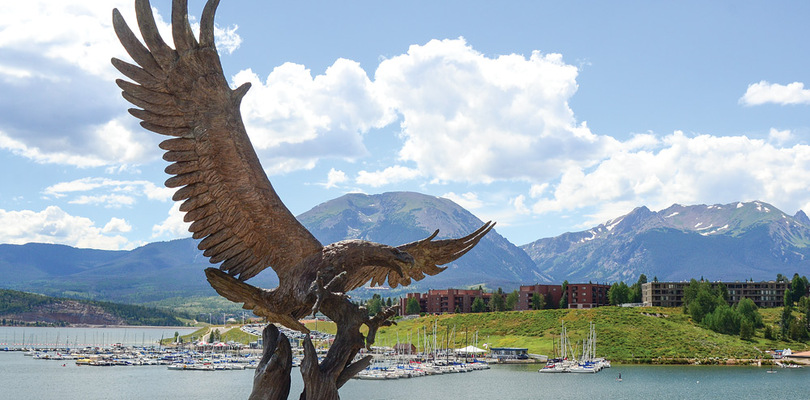Sailing where eagles soar

Colorado’s Lake Dillon was a busy place in the last weeks of the summer. The Dillon Yacht Club, the country’s highest yacht club at 9,017 feet above sea level, hosted a series of events, including US Sailing Junior Olympic Regatta, the regional Etchells Class Championship, which was blown off on its second day by a 50-knot squall, and finally the annual Dillon Open.
In its 46th year, the Dillon Open attracted 67 boats, including PHRF racers, and one-designs such as Star, Santana 20, Ensign and Catalina 22. The Santana 20s had the largest class with 16 boats warming up for their championship the following week.
Pulling off a successful regatta in the heart of the Rocky Mountain ski country is no small feat. In August the rain squalls march through the Gore Mountain Range near Vail and over the Ten Mile Range between the ski town of Breckenridge and Frisco on the western shore of the lake, a reservoir built in the mid 1960s as a water supply for Denver.
Wind shifts of 90 to 180 degrees are not unusual on Lake Dillon, so the club has devised a plan that works for quick course changes between races or even between classes. The committee boat is moored to a buoy anchored in 300 feet at the center of the lake. The pin is also anchored but can be moved to set the line square to the wind without much effort. There are a dozen buoys set around the lake, numbered on local charts 1 to the North to 12 in the West, that serve as windward and leeward marks. The finish mark is an inflatable offset from the final leeward mark to prevent simultaneous mark roundings and finishes by different classes.
On the first race day, winds came from the north across the Dillon Dam for the first race of each class. The Star class got off a second race, but a threatening storm crossing the valley North of Silverthorne and moving toward the lake led to the cancellation of further racing for Saturday, with the race committee hoping to avoid a repeat of the storm that had damaged the Etchells class.
On the final day, after an hour of drifting, the wind finally filled in at about 12 knots from the west. The shifty wind kept the race committee on its toes, finally shifting to a fresh 25-knot north wind from a passing cold front.
The Dillon Open was originally called Skiyachting, and had been organized for Memorial Day weekend by a crew of Denver sailors, who made plans in 1966 for the first combined sailing and skiing regatta in the U.S. It was the ultimate Colorado challenge, where several dozen “skailors” met at the Arapahoe Basin ski area for men’s and women’s giant slalom on the first day. The next day a regatta was raced aboard catamarans and centerboard monohulls, such as Butterflies and Ynglings and Sunfish on the cold water.
By 1971, sailors abandoned the Skiyachting races and moved the sailboat racing to the warmer first weekend in August where it became the Dillon Open Regatta. It became a series of traditional sailboat races, as it is today, but it still featured the unpredictability of sailing on a high-alpine lake with constantly changing winds, offering real tactical challenges and surprising microbursts popping down from the high mountains.
“This is the land of curve balls. We have no idea what the weather will do. We never do,” said Dillon Y.C. Comm. DB Tanner.
It was the same crazy weather for the Santana 20 Championship sailed the following week.
“Dillon dished out some very challenging conditions again with winds ranging from 4 to 30 knots in short time frames,” said race committee member Paul Kresge. “The racing was very challenging with the gusty wind. On the second downwind leg a big gust hit the group. One mast broke, one boat capsized and turtled. The crew was able to get the boat up from the turtle but then the stern sank with only the bow floating. We got a line on the bow and the sheriff hauled it to shore.”
That’s all in a day of sailing on Lake Dillon in Colorado.

Comments